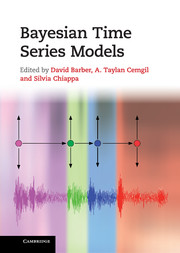Book contents
- Frontmatter
- Contents
- List of contributors
- Preface
- 1 Inference and estimation in probabilistic time series models
- I Monte Carlo
- II Deterministic approximations
- 5 Two problems with variational expectation maximisation for time series models
- 6 Approximate inference for continuous-time Markov processes
- 7 Expectation propagation and generalised EP methods for inference in switching linear dynamical systems
- 8 Approximate inference in switching linear dynamical systems using Gaussian mixtures
- III Switching models
- IV Multi-object models
- V Nonparametric models
- VI Agent-based models
- Index
- Plate section
- References
7 - Expectation propagation and generalised EP methods for inference in switching linear dynamical systems
from II - Deterministic approximations
Published online by Cambridge University Press: 07 September 2011
- Frontmatter
- Contents
- List of contributors
- Preface
- 1 Inference and estimation in probabilistic time series models
- I Monte Carlo
- II Deterministic approximations
- 5 Two problems with variational expectation maximisation for time series models
- 6 Approximate inference for continuous-time Markov processes
- 7 Expectation propagation and generalised EP methods for inference in switching linear dynamical systems
- 8 Approximate inference in switching linear dynamical systems using Gaussian mixtures
- III Switching models
- IV Multi-object models
- V Nonparametric models
- VI Agent-based models
- Index
- Plate section
- References
Summary
Introduction
Many real-world problems can be described by models that extend the classical linear Gaussian dynamical system with (unobserved) discrete regime indicators. In such extended models the discrete indicators dictate what transition and observation model the process follows at a particular time. The problems of tracking and estimation in models with manoeuvring targets [1], multiple targets [25], non-Gaussian disturbances [15], unknown model parameters [9], failing sensors [20] and different trends [8] are all examples of problems that have been formulated in a conditionally Gaussian state space model framework. Since the extended model is so general it has been invented and re-invented many times in multiple fields, and is known by many different names, such as switching linear dynamical system, conditionally Gaussian state space model, switching Kalman filter model and hybrid model.
Although the extended model has a lot of expressive power, it is notorious for the fact that exact estimation of posteriors is intractable. In general, exact filtered, smoothed or predicted posteriors have a complexity exponential in the number of observations. Even when only marginals on the indicator variables are required the problem remains NP-hard [19].
In this chapter we introduce a deterministic approximation scheme that is particularly suited to find smoothed one and two time slice posteriors. It can be seen as a symmetric backward pass and iteration scheme for previously proposed assumed density filtering approaches [9].
The chapter is organised as follows. In Section 7.2 we present the general model; variants where only the transition or only the observation model switch, or where states or observations are multi-or univariate can be treated as special cases.
- Type
- Chapter
- Information
- Bayesian Time Series Models , pp. 141 - 165Publisher: Cambridge University PressPrint publication year: 2011



